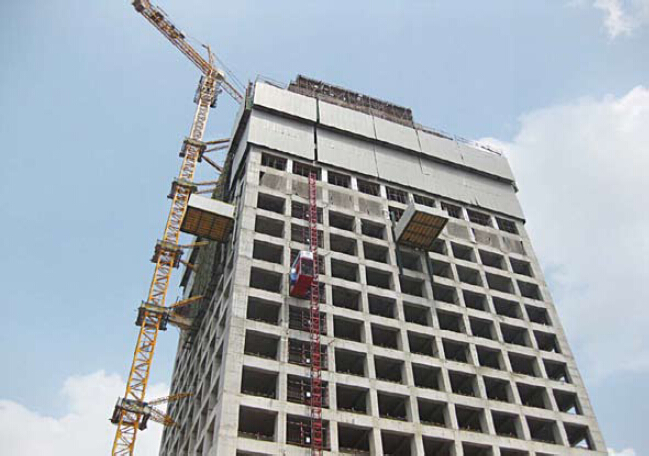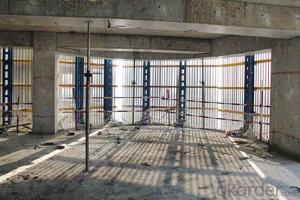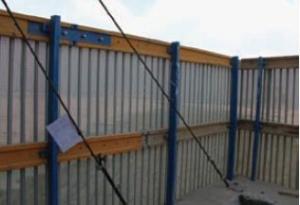Protection Platform for Formwork and Scaffolding Construction
- Loading Port:
- Tianjin
- Payment Terms:
- TT OR LC
- Min Order Qty:
- 50 m²
- Supply Capability:
- 1000 m²/month
OKorder Service Pledge
OKorder Financial Service
You Might Also Like
Protection Platform PP-50
A kind of new type construction protection system, applying operating platform and safer job
location for construction corps.
Characteristics:
◆ Easy and quick assembling.
◆ Lifted as a group, it is rapid and economic.
◆ Auto-climbing
◆ A safe and reliable anchor system
1. Composition
2. Assembly process of anchor system
(1) Embed V-climbing cone and anchor plate into the slab.
(2) Fix anchor shoe on the slab by tensile bolt.
(3) The fixed anchor shoe.
◆ High work efficiency with work platform and unload platform
◆ High light transmittance with the hollow block


- Q:How does steel formwork handle complex geometries?
- Steel formwork is able to handle complex geometries due to its inherent strength and flexibility. The steel panels can be easily cut and shaped to fit intricate designs, allowing for the creation of complex shapes and curves. Additionally, steel formwork can be assembled and disassembled, making it highly adaptable to different geometries and construction requirements. The rigidity and stability of steel also ensure that the formwork maintains its shape during concrete pouring, resulting in precise and accurate structures. Overall, steel formwork offers the versatility and durability needed to effectively handle complex geometries in construction projects.
- Q:Can steel formwork be used for projects with limited formwork transportation options?
- Projects with limited formwork transportation options can utilize steel formwork. Steel formwork is renowned for its durability, strength, and reusability, making it an excellent selection for projects that necessitate transportation over extensive distances or challenging terrains. Unlike traditional wood formwork, steel formwork can endure transportation challenges without experiencing damage or deformation. Moreover, steel formwork is lightweight in comparison to other formwork materials like concrete or timber, which facilitates transportation even in areas with restricted transportation options. The lightweight attribute of steel formwork not only reduces transportation expenses but also enables easier handling and on-site installation. Furthermore, steel formwork can be effortlessly dismantled and reassembled, making it suitable for projects that often require formwork transportation. The modular design of steel formwork allows for convenient transportation and reconfiguration, ensuring efficient transportability to various project sites as necessary. In conclusion, steel formwork is a versatile and pragmatic solution for projects with limited formwork transportation options. Its durability, lightweight nature, and ease of disassembly and reassembly make it an appropriate choice for projects that mandate formwork transportation over extensive distances or challenging terrains.
- Q:What are the different steel grades used in steel formwork?
- There are various steel grades used in steel formwork, including mild steel, high-strength low-alloy (HSLA) steel, and stainless steel. These grades are selected based on the specific requirements of the construction project, such as load-bearing capacity, durability, and resistance to corrosion.
- Q:Can steel formwork be used for both manual and mechanical concrete pouring?
- Yes, steel formwork can be used for both manual and mechanical concrete pouring. The strength and durability of steel make it suitable for various construction methods, allowing for flexibility in concrete pouring techniques.
- Q:Can steel formwork be used for elevated slabs?
- Indeed, elevated slabs can be constructed using steel formwork. Steel formwork serves as a flexible and long-lasting choice for the construction of elevated slabs. It presents a robust and inflexible framework capable of withstanding the weight of the slab and any additional burdens. Moreover, steel formwork offers the added benefit of being reusable, thereby enabling savings in cost and enhancing efficiency in construction endeavors. Furthermore, steel formwork can be effortlessly modified and tailored to meet specific design requisites, rendering it suitable for diverse kinds of elevated slabs. In summary, due to its strength, durability, reusability, and adaptability, steel formwork stands as a dependable alternative for the construction of elevated slabs.
- Q:How does steel formwork affect the quality of concrete?
- Steel formwork can greatly affect the quality of concrete by providing a stable and precise mold for the concrete to be poured into. The use of steel formwork helps ensure uniformity in shape, size, and surface finish of the concrete, resulting in a higher quality and more consistent end product. The strength and durability of steel formwork also enable it to withstand the pressure exerted by the wet concrete, preventing any deformation or leakage that could compromise the integrity of the concrete structure.
- Q:How does steel formwork contribute to the overall structural integrity of a building?
- Steel formwork contributes to the overall structural integrity of a building by providing a strong and rigid framework for pouring concrete. It ensures accurate alignment and dimensional stability, resulting in consistent and reliable construction. The use of steel formwork also enhances the load-bearing capacity of the structure, allowing it to withstand heavy loads and external forces. Additionally, steel formwork offers excellent durability and longevity, reducing the risk of structural failures over time.
- Q:What are the common cost-saving strategies when using steel formwork?
- Some common cost-saving strategies when using steel formwork include reusing the formwork for multiple projects, accurately measuring and cutting the formwork materials to minimize waste, properly maintaining and storing the formwork to prolong its lifespan, and utilizing innovative formwork systems that allow for faster installation and dismantling.
- Q:What are the common types of steel used for formwork?
- The specific application and requirements determine the common types of steel used for formwork. However, in formwork construction, several types of steel are commonly utilized. 1. Mild Steel: This type of steel is frequently employed in formwork due to its affordability, accessibility, and ease of manipulation. With a low carbon content, mild steel is relatively pliable and can be easily bent or shaped. Nevertheless, it may not be suitable for heavy-duty or high-stress applications. 2. High Tensile Steel: Also known as high-strength steel, high tensile steel is a sturdier and more resilient alternative to mild steel. It contains alloys that enhance its tensile strength, making it perfect for heavy-duty formwork applications that involve higher loads or stresses. Although high tensile steel is more expensive than mild steel, it offers superior structural integrity. 3. Stainless Steel: In formwork applications where corrosion resistance is crucial, stainless steel is often employed. With a high chromium content, it forms a protective layer on the surface, preventing rust and corrosion. Stainless steel is commonly used in marine or coastal construction projects, as well as in areas with high humidity or chemical exposure. 4. Reinforcing Steel: Also known as rebar, reinforcing steel is frequently used in reinforced concrete formwork. It comprises steel bars or mesh embedded within the concrete to provide additional strength and stability. Reinforcing steel is typically made of carbon steel, but stainless steel rebar is also available for applications that require corrosion resistance. When selecting the appropriate type of steel for formwork, it is important to consider factors such as load requirements, environmental conditions, and budget constraints. Consulting with a structural engineer or construction professional can help ensure the right steel type is chosen for the specific project.
- Q:Can steel formwork be used for underwater concrete structures?
- Yes, steel formwork can be used for underwater concrete structures. Steel formwork is known for its durability, strength, and ability to withstand harsh environmental conditions. When used for underwater concrete structures, steel formwork provides a reliable and stable framework for pouring and shaping the concrete. It can withstand the pressure and forces exerted by water, ensuring that the concrete is properly contained and shaped as desired. Additionally, steel formwork is resistant to corrosion, which is important in an underwater environment where the risk of rusting is higher. Overall, steel formwork is a suitable choice for underwater concrete structures due to its strength, durability, and resistance to corrosion.
1. Manufacturer Overview |
|
|---|---|
| Location | |
| Year Established | |
| Annual Output Value | |
| Main Markets | |
| Company Certifications | |
2. Manufacturer Certificates |
|
|---|---|
| a) Certification Name | |
| Range | |
| Reference | |
| Validity Period | |
3. Manufacturer Capability |
|
|---|---|
| a)Trade Capacity | |
| Nearest Port | |
| Export Percentage | |
| No.of Employees in Trade Department | |
| Language Spoken: | |
| b)Factory Information | |
| Factory Size: | |
| No. of Production Lines | |
| Contract Manufacturing | |
| Product Price Range | |
Send your message to us
Protection Platform for Formwork and Scaffolding Construction
- Loading Port:
- Tianjin
- Payment Terms:
- TT OR LC
- Min Order Qty:
- 50 m²
- Supply Capability:
- 1000 m²/month
OKorder Service Pledge
OKorder Financial Service
Similar products
New products
Hot products
Related keywords
























